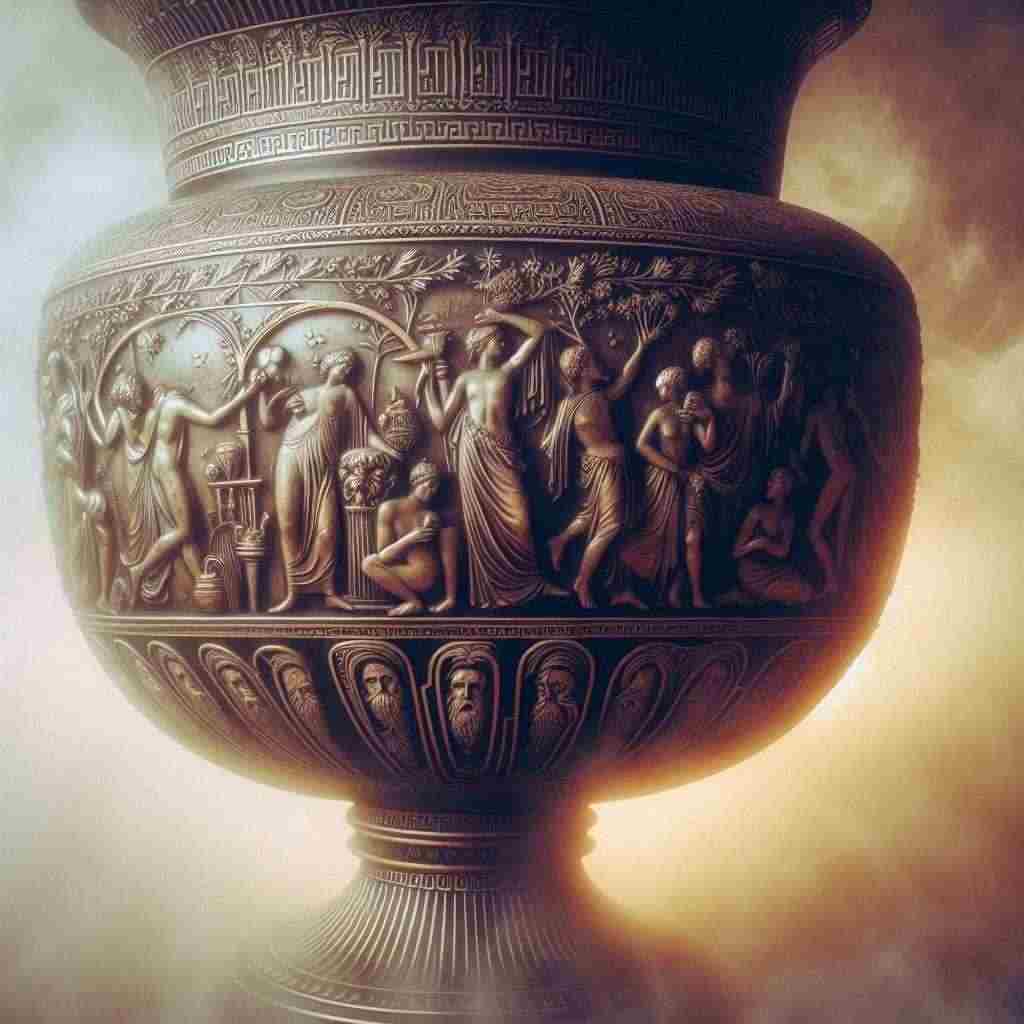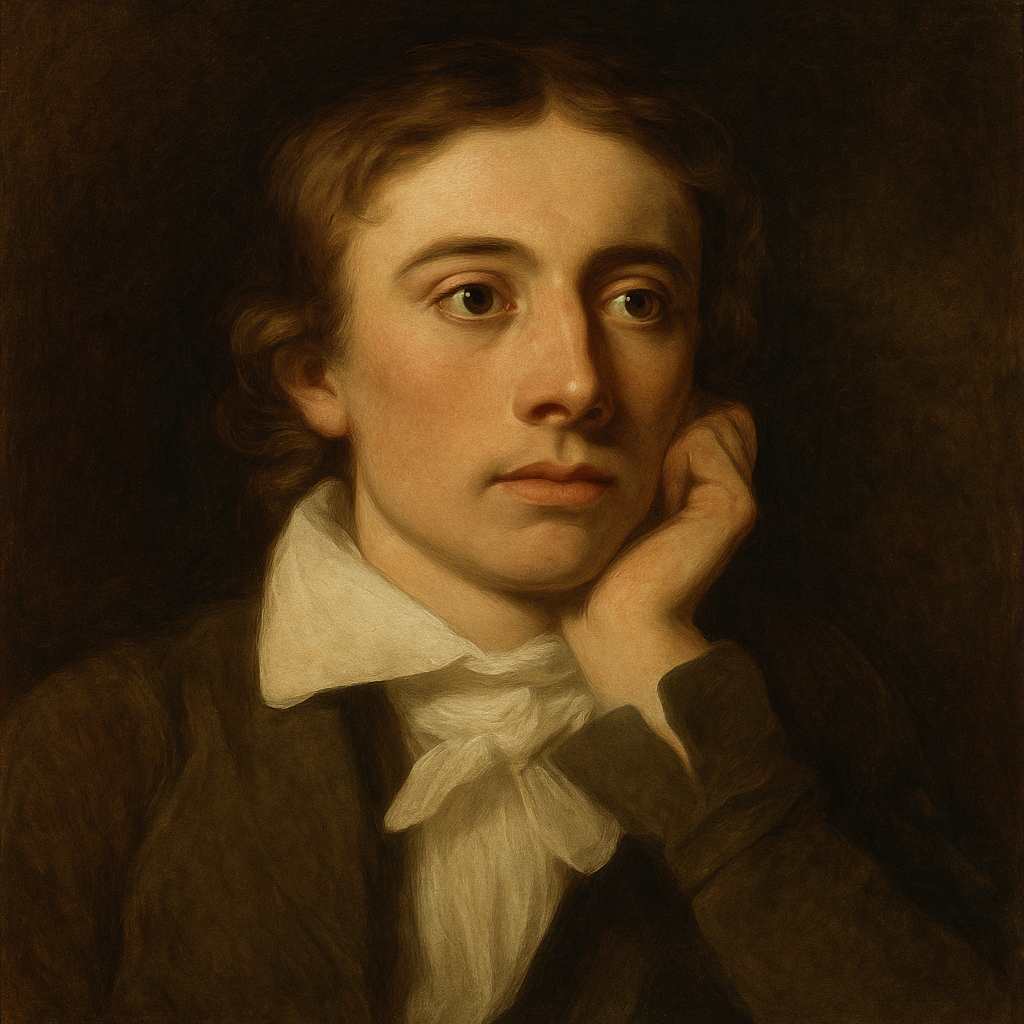Ode on a Grecian Urn
John Keats
1795 to 1821

Thou still unravish'd bride of quietness,
Thou foster-child of silence and slow time,
Sylvan historian, who canst thus express
A flowery tale more sweetly than our rhyme:
What leaf-fring'd legend haunts about thy shape
Of deities or mortals, or of both,
In Tempe or the dales of Arcady?
What men or gods are these? What maidens loth?
What mad pursuit? What struggle to escape?
What pipes and timbrels? What wild ecstasy?
Heard melodies are sweet, but those unheard
Are sweeter; therefore, ye soft pipes, play on;
Not to the sensual ear, but, more endear'd,
Pipe to the spirit ditties of no tone:
Fair youth, beneath the trees, thou canst not leave
Thy song, nor ever can those trees be bare;
Bold Lover, never, never canst thou kiss,
Though winning near the goal yet, do not grieve;
She cannot fade, though thou hast not thy bliss,
For ever wilt thou love, and she be fair!
Ah, happy, happy boughs! that cannot shed
Your leaves, nor ever bid the Spring adieu;
And, happy melodist, unwearied,
For ever piping songs for ever new;
More happy love! more happy, happy love!
For ever warm and still to be enjoy'd,
For ever panting, and for ever young;
All breathing human passion far above,
That leaves a heart high-sorrowful and cloy'd,
A burning forehead, and a parching tongue.
Who are these coming to the sacrifice?
To what green altar, O mysterious priest,
Lead'st thou that heifer lowing at the skies,
And all her silken flanks with garlands drest?
What little town by river or sea shore,
Or mountain-built with peaceful citadel,
Is emptied of this folk, this pious morn?
And, little town, thy streets for evermore
Will silent be; and not a soul to tell
Why thou art desolate, can e'er return.
O Attic shape! Fair attitude! with brede
Of marble men and maidens overwrought,
With forest branches and the trodden weed;
Thou, silent form, dost tease us out of thought
As doth eternity: Cold Pastoral!
When old age shall this generation waste,
Thou shalt remain, in midst of other woe
Than ours, a friend to man, to whom thou say'st,
"Beauty is truth, truth beauty, - ”that is all
Ye know on earth, and all ye need to know."
John Keats's Ode on a Grecian Urn
John Keats's "Ode on a Grecian Urn" stands as a masterpiece of Romantic poetry, offering a profound meditation on the nature of art, beauty, and the human experience. Through his vivid imagery and complex reflections, Keats explores the tension between the eternal world of art and the transient realm of human life, ultimately positing art as a transcendent force that both challenges and consoles us in the face of mortality.
The poem opens with an apostrophe to the urn, personifying it as an "unravish'd bride of quietness" and a "foster-child of silence and slow time." This immediate personification establishes the urn as more than a mere object; it becomes a sentient entity, capable of preserving and communicating stories from antiquity. The epithet "Sylvan historian" further emphasizes the urn's role as a keeper of pastoral tales, positioning it as a bridge between the ancient Greek world and Keats's contemporary audience.
As the speaker contemplates the scenes depicted on the urn, Keats employs a series of questions that serve multiple purposes. These queries not only describe the images but also convey a sense of wonder and mystery surrounding the frozen narratives. The repetition of "What" at the beginning of several lines in the first stanza creates a rhythmic urgency, mirroring the speaker's eager curiosity. This technique also draws the reader into the process of interpretation, encouraging us to engage with the urn's enigmatic representations actively.
The second stanza introduces one of the poem's central paradoxes: the superiority of "unheard" melodies over those that are heard. This concept speaks to the power of imagination and the idealized nature of art. The music depicted on the urn, forever silent, becomes more perfect in its potential than any actual melody could be. This idea extends to the frozen scenes of youth and love, where the speaker finds a bittersweet beauty in their eternal stasis. The lover, forever on the brink of a kiss, and the beloved, never fading, represent an idealized love that transcends the imperfections and decay of reality.
Keats's use of repetition and exclamation in the third stanza ("happy, happy boughs!" and "More happy love! more happy, happy love!") creates a sense of ecstatic appreciation for the urn's eternal spring. However, this celebration is undercut by the recognition that such perpetual bliss is unattainable in the human realm. The contrast between the urn's "for ever young" inhabitants and the "breathing human passion" that leaves one with "A burning forehead, and a parching tongue" highlights the double-edged nature of art's perfection. While it offers an escape from mortality, it also serves as a painful reminder of human limitations.
The fourth stanza shifts focus to a different scene on the urn, depicting a religious procession. The speaker's questions about the origin and destination of this group underscore the mysterious nature of the urn's representations. The image of the "little town" emptied of its inhabitants for the ceremony introduces a somber note, as the speaker reflects on the town's eternal silence and abandonment. This stanza serves as a poignant reminder of the cost of immortalization in art - the sacrifice of life's vitality and change.
In the final stanza, Keats broadens his reflection to address the urn's overall significance. The urn is described as an "Attic shape" and a "Cold Pastoral," emphasizing both its Classical origins and its removed, emotionless nature. Yet, paradoxically, this "silent form" has the power to "tease us out of thought / As doth eternity." Here, Keats suggests that art's very inscrutability and timelessness can lead us to profound contemplation of existence itself.
The poem concludes with the famous lines attributed to the urn: "Beauty is truth, truth beauty, - that is all / Ye know on earth, and all ye need to know." This enigmatic statement has been the subject of much critical debate. It can be interpreted as a celebration of art's ability to distill essential truths about the human experience into beautiful forms. Alternatively, it might be seen as an ironic comment on the limitations of art's perfect but static world when compared to the complex, evolving nature of lived experience.
Throughout "Ode on a Grecian Urn," Keats employs rich sensory imagery, varied rhyme schemes, and a complex interplay of ideas to create a multi-layered exploration of art's role in human life. The poem's enduring power lies in its ability to hold multiple, sometimes contradictory, truths in tension: the appeal of artistic permanence versus the vitality of lived experience, the beauty of idealization versus the richness of reality, and the consolation of aesthetic pleasure versus the inevitability of death and change.
In conclusion, "Ode on a Grecian Urn" stands as a testament to Keats's poetic genius, offering readers a profound meditation on the nature of art and its relationship to human existence. Through his nuanced treatment of the urn as both object and symbol, Keats invites us to consider the complex interplay between the eternal and the ephemeral, challenging us to find meaning and solace in the face of our own mortality.
This text was generated by AI and is for reference only. Learn more
Want to join the discussion? Reopen or create a unique username to comment. No personal details required!



Comments
No comments yet. Be the first to comment!